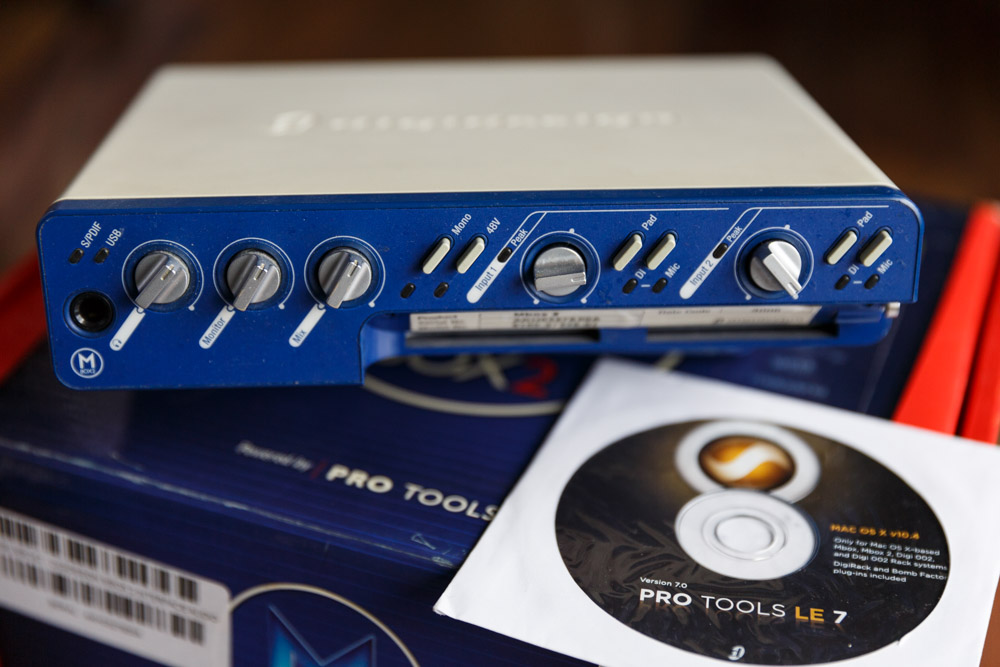

Other parameters that are of common interest in specifications are noise, crosstalk, and slew rate limit. If you can, then please sign your name up for 'golden ear' tests now. Having worked with many, many students on analog tape recorders displaying distortions of around the 1% mark, even when things are going well, I can say with certainty that very few people can perceive distortion below 0.1%. So could it be a question of distortion perhaps? Digidesign's spec on this is 0.003% at 1 kHz. Try and find a loudspeaker that goes down to 20 Hz anyway. Practically the whole of the audio world regards 20 Hz to 20 kHz as being sufficient, so I can't see any problem with this. Digidesign's spec says +/-0.5 dB, 20 Hz – 20 kHz. It might seem to have something to do with frequency response. can the quality of bass punch be measured?

I like to think of myself a having a combination of musical and technical abilities, so my first thoughts were these. In their review of the Digidesign Mbox 2 audio interface, which comes with the excellent Pro Tools LE software, the review commented that the sound lacked 'bass punch'. In this case I was reading a mag that shall remain nameless, but it isn't one of my favorites as it seems happy to encourage its readers to stay in their bedroom studios, endlessly consuming equipment, rather than getting out into the real world and doing stuff, which is what music is all about really. However sometimes, they might shed light on an interesting line of enquiry. So what the magazines say doesn't usually make a difference.
#Digidesign mbox 2 pro reviews professional
Of course, Audio Masterclass only bases its opinion on actual use, reports from professional users or audio evidence from home users.

($799 MSRP of the fun tasks of having a website like this is reading all the recording magazines to see what they have to say.
#Digidesign mbox 2 pro reviews drivers
ASIO, WaveDriver, and CoreAudio drivers guarantee that the Pro will work with just about every audio application, but of course, it comes with ProTools LE 7.3 (Tape Op #57) as well as over 50 plug-ins, applications, and virtual instruments (same as the other Mbox 2 bundles). The unit is built well, and disagreeing with Dana Gumbiner, who was unhappy with the shape of the knobs when he reviewed the Mbox 2, I like the knobs and switches because they aren't likely to break off when you throw the sucker into your backpack. Unfortunately, external sync to the WC input is only available at 44.1 and 48 kHz rates. Moreover, the Pro is the only one in its line that supports 96 kHz operation. Compared to the Mini (I didn't have an original Mbox 2 to compare), the Pro has better sounding mic preamps, less roll-off on the DIs, and headphone amps with lower noise and higher volume. Furthermore, the quality of analog I/O has been upgraded for the Pro. The rest of the Mbox 2 line seems geared toward folks who are recording themselves, but the Pro stands out for having features that allow an engineer to record one or more musicians while monitoring a mix that's different from the artists' cue mix. There are two headphone jacks each has its own volume knob, and the second jack can monitor Line Out 1/2 or 3/4. Used in conjunction with the S/PDIF digital I/O, you can record up to six inputs at a time and play through eight outputs simultaneously. Of the six analog outputs, Line Outs 1-4 are on TRS, and Line Outs 5/6 are on a single stereo TRS. Additionally, the stereo Aux In is switchable between a pair of TRS line jacks or RCA connectors that feed an internal phono preamp. Inputs 1 and 2 can be individually switched between rear-panel Neutrik Combo (XLR/TRS) mic/line ins and front-panel 1/4" DIs. Tape Op #51 and #57 for reviews of the Mbox 2 and Mbox 2 Mini), the Pro connects to the host via FireWire instead of USB, it supports 88.2 and 96 kHz sample rates, and it features expanded I/O. Unlike the other Mbox 2 interfaces for Pro Tools LE (see


 0 kommentar(er)
0 kommentar(er)
